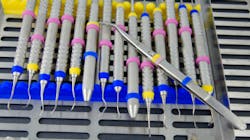Why your employer should care about dull instruments
The hygiene appointment is known throughout the industry to be an important source of production and overall practice health. Though the exact figure varies, most industry experts suggest that hygiene production as a percentage of overall production should be about 30%.1
This means that the tools hygienists have to work with directly affect the financial fate of a practice. In the August 2016 issue of Dental Economics, Chris Salierno, DDS, wrote that “Your hygiene systems are arguably the most important in your practice. We must keep a healthy supply of patients flowing into our practice, give them an outstanding experience, diagnose any disease that is present, and correctly bill for the services provided. There are a lot of moving parts here and a critical failure at any step can cost you lost revenue and, even worse, lost patients.”2
One moving part—literally—is the scraping of a scaler against enamel, doing the all-important job of removing calculus. Though judging from the survey comments, many dentists see sharpening as either a hygienist’s “problem” or a waste of time altogether. Why? Arguably it’s a lack of understanding of how dull instruments impact their practices, and with this last article, I’d like to take a more bird’s-eye view of the importance of sharp instruments. Some of the previous articles in this series have briefly touched on these points, and we’ll dive into them further here.
Patients—through no fault of their own—are usually not qualified to judge the quality of care they receive at an appointment.3 They are often only left with how dental professionals made them feel, whether emotionally or physically. And what is the first sustained point of contact a patient usually makes with a practice? The hygiene appointment. The hygienist continues to be the face of the practice for most patients, and their experience of the prophy is their only yardstick for judging other potential procedures.
If a hygienist has to work with dull instruments, he or she often compensates by pressing harder, and it takes longer to remove calculus this way, if it truly gets removed at all. This method is often perceived as more painful by the patient. Add to that a pre-existing cultural association of dentistry with pain, and the prominence of bad reviews online, and it’s clear that dull instruments are a liability to a practice as a whole, both in terms of patients’ perceptions and their oral health.
While a practice owner may save money in the short term by not giving hygienists ample time to sharpen, paying for a sharpening service, or buying sharpening equipment, these savings come at a high cost later on. Instruments are consumable items that have to be maintained or replaced in the normal course of practicing dentistry. In addition to not getting time to sharpen, many hygienists reported that they were not getting new instruments very often either—the average reported time a scaler is used is eight years! One survey respondent said, “The last time I begged for instruments, my boss said, ‘What are you doing? Eating these things?’ He has not bought me new hand instruments since I started there, 6.5 years ago, and I inherited old instruments at that time.”
As mentioned in previous articles, the consequences of dull instruments can come in many forms: patients may get frustrated with pain or poor oral health and leave the practice, only to complain to friends and family later; clinicians may suffer ergonomic pain and injury; appointments may take longer.4 A practice naturally loses patients each month through factors such as relocation, so if these patients are not replaced with happy new customers, a practice’s growth can be restricted.
Though the cost of each form of sharpening can vary, let’s look at one possible solution. A new line of hygiene instruments (Xdura by Nordent) includes free professional sharpening by the manufacturer, for example. Based on the cost of the instruments, the manufacturer estimates that each patient encounter costs the practice owner $.35 to $.48.
After talking to hygienists at trade shows and continuing education events for many years, Tim Irwin, an executive at Nordent Manufacturing, has found that “the number one complaint patients have about a hygienist and the number one reason a patient leaves a hygienist is that she or he is too rough. This is rarely the skill of the hygienist. It is because she is forced to work with dull, beat up instruments. If dentists want to grow their practices, they should make sure their patients have a great experience during the hygiene appointment and receive comfortable, high quality care.”
The majority of hygienists responding to our survey said that they didn’t have time during their days to sharpen (let alone getting paid time to sharpen). They did it after hours at home if they could, but of course this is a problematic situation. Hygienists are almost always not independent contractors (despite widespread misunderstanding about this) and should not be pressured to maintain their equipment as if they were.
Your time as a hygienist is valuable and essential to the growth of the practice. Using this article and the others from this series, we hope RDH has given you tools to get a bigger picture of what’s happening in the profession with sharpening and advocate for better practices.
References
1. Wall R. Hygiene production as percentage of total production. DentistryIQ website. https://www.dentistryiq.com/articles/2018/10/hygiene-production-as-percentage-of-total-production.html. Published October 18, 2018. Accessed January 14, 2019.
2. Salierno C. Yes, you have a hygiene department. Dental Economics website. https://www.dentaleconomics.com/articles/print/volume-106/issue-8/in-every-issue/editor-s-note/yes-you-have-a-hygiene-department.html. Published August 24, 2016. Accessed January 14, 2019.
3. Asmus DG. The universal patient concerns you should not ignore. Dental Economics website. https://www.dentaleconomics.com/articles/print/volume-108/issue-8/practice/the-universal-patient-concerns-you-should-not-ignore.html. Published August 1, 2018. Accessed January 14, 2019.
4. DeStefano AW. The ballad of time, money, and instrument sharpening. RDH website. https://www.rdhmag.com/articles/print/volume-38/issue-9/content/the-ballad-of-time-money-and-instrument-sharpening.html. Published September 1, 2018. Accessed January 14, 2019.
Amelia Williamson DeStefano, MA, is one of the managing editors of RDH magazine. She also works on RDH eVillage and Dental Economics.
About the Author
Amelia Williamson DeStefano, MA
Amelia Williamson DeStefano, MA, is group editorial director of the Endeavor Business Media Dental Group, where she leads the publication of high-quality content that empowers oral-health professionals to advance patient well-being, succeed in business, and cultivate professional joy and fulfillment. She holds a master's in English Literature from the University of Tulsa and has worked in dental media since 2015.
Updated May 16, 2023

